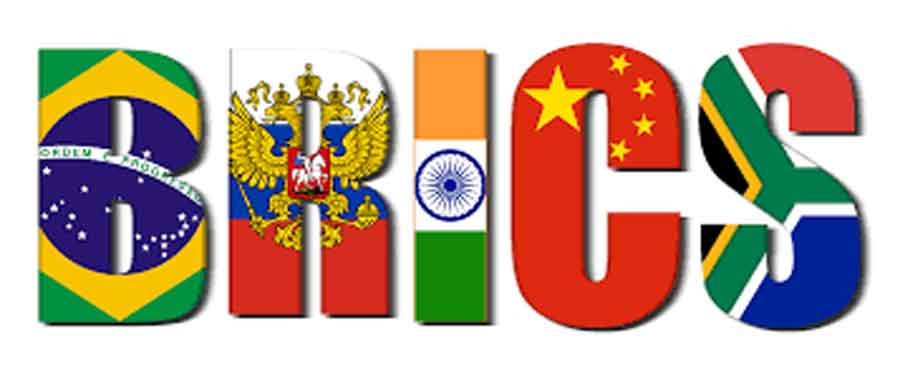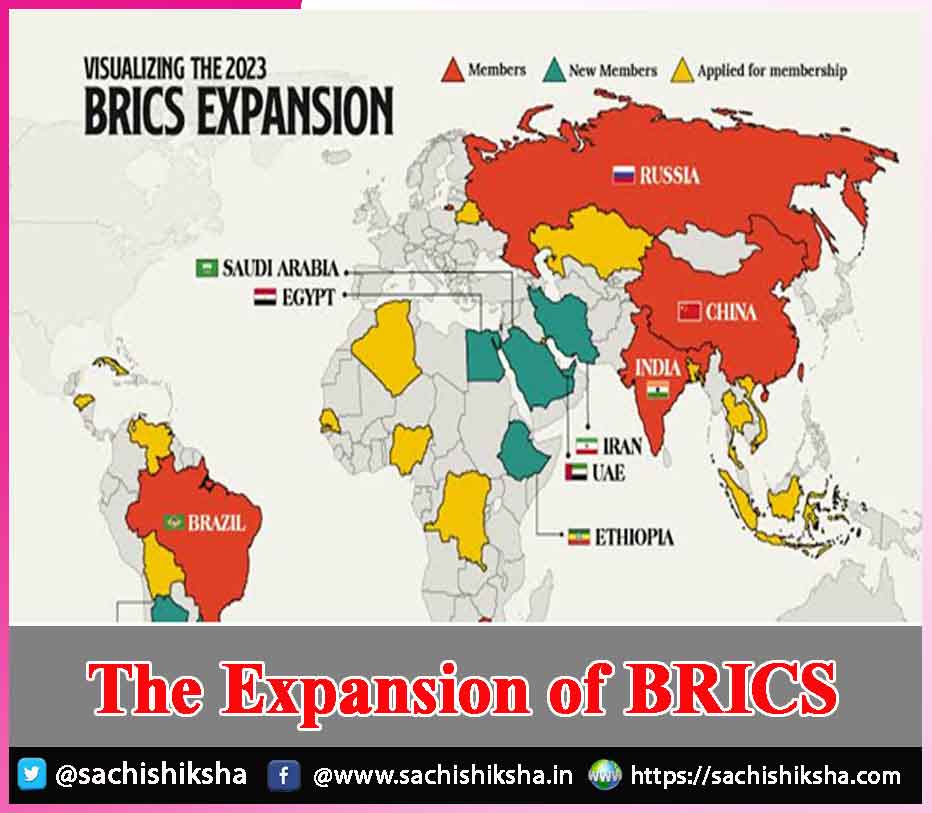The Expansion of BRICS
Introduction: In international politics and economics, few developments have been as consequential in the 21st century as the expansion of BRICS. What began as a promising acronym in 2001, focusing on the economic powerhouses of Brazil, Russia, India,
and China (hence BRIC), has since evolved into a globally influential alliance, including South Africa, in 2010, changing the name to BRICS. This expansion of BRICS has reshaped the geopolitical landscape and holds vast implications for the international order. This article lets us explore the origins of BRICS, the dynamics of its expansion, and the manifold ways it has impacted global politics and economics.
Table of Contents
BRICS: A Brief Historical Context:

Brazil:
Brazil, the first member of BRICS, is the largest country in South America. Its economic significance lies in its vast natural resources, including agriculture, energy, and minerals. Brazil’s multifaceted culture and rich history have contributed to its position as a global player.
Russia:
Russia, the second BRICS member, is the world’s largest nation by land area. It wields tremendous influence in the energy sector, mainly through its natural gas and oil reserves. Given Russia’s historical significance as a superpower Russian politics and foreign policy have long been subjects of international intrigue.
India:
India, the third member of BRICS, is renowned for its massive population, rich cultural heritage, and rapidly expanding economy. Its information technology (IT) industry has gained global recognition, and a young and dynamic workforce contributes to its ongoing economic growth.
China:
China, the final original member of BRICS, is the world’s most populous country. It has ascended to the status of a global economic juggernaut, driven by rapid industrialization, technological innovation, and the growth of its middle class.
The Expansion of BRICS:
The expansion of BRICS, adding South Africa to the group in 2010, was a pivotal moment in the history of this alliance. South Africa brought a distinctive regional perspective, increased diversity, and a new dimension to the group’s influence.
South Africa:
The newest member of BRICS, South Africa, served as the gateway to the African continent. As the most industrialized and economically developed nation on the African continent, South Africa brought a wealth of natural resources and a multicultural society. This expansion broadened the BRICS’ geographical scope and marked an important shift in the global balance of power.
Implications of BRICS Expansion:
The expansion of BRICS profoundly impacted many fronts, both at the global level and within the individual member countries.
Economic Powerhouse:
At the core of BRICS’ existence is its economic influence. Each original BRICS nation represented a considerable portion of the global economy. The inclusion of South Africa bolstered this collective strength and broadened the alliance’s economic base. It allowed BRICS to challenge the economic dominance of Western powers and significantly shape international economic policies.
Geopolitical Significance:
BRICS was not just an economic alliance but also a geopolitical one. South Africa’s inclusion broadened the group’s geographical reach into Africa, the world’s second-most populous continent. In an evolving global landscape characterized by shifting geopolitical dynamics, with its expanded roster, BRICS became a more balanced representation across different continents, thereby strengthening its geopolitical influence.
Development Initiatives:
BRICS has always prioritized development initiatives, especially in emerging and underdeveloped regions. Member countries collaborated on projects and financial institutions like the New Development Bank (NDB), formerly the BRICS Development Bank. This institution is designed to fund infrastructure and sustainable development projects in BRICS countries and beyond. South Africa’s inclusion further broadened the scope of such initiatives, enabling BRICS to engage in more comprehensive development efforts.
Global Governance Reform:
BRICS member nations have consistently advocated for reforms in global governance institutions like the United Nations and the International Monetary Fund. They aim to secure more excellent representation and decision-making power for emerging economies in these organizations. The inclusion of South Africa helped BRICS address the underrepresentation of African nations in global institutions.
South-South Cooperation:
The expansion of BRICS symbolizes the idea of South-South cooperation, where countries from the Southern Hemisphere unite to address shared challenges and pursue mutual benefits. This form of collaboration challenges the traditional North-South paradigm, in which developed countries from the Northern Hemisphere often dictate global policies. BRICS has demonstrated that emerging economies from different continents can join forces to assert their influence on international affairs.
Challenges and Opportunities:
While the expansion of BRICS has brought about numerous advantages, it has also presented some challenges and opportunities.
Diverse Interests:
The BRICS countries are incredibly diverse in culture, politics, and economic development. Each nation has unique priorities and interests, sometimes leading to differences in approach and policy. The challenge lies in finding common ground and consensus, particularly on sensitive international issues.
Cooperation in a Multipolar World:
As BRICS expanded, it had to navigate the complexities of a multipolar world. The rise of other regional groupings and power centers, such as the Shanghai Cooperation Organization (SCO) and the G20, has added complexity to the global landscape. BRICS must adapt to and compete for relevance in this evolving environment.
Economic Challenges:
Economic fluctuations within member countries can impact the collective strength of BRICS. In recent years, some BRICS nations have faced economic slowdowns, which can affect the group’s ability to fulfill its financial objectives and commitments.
Bridging the Development Gap:
A persistent challenge for BRICS is addressing the development gap among its members. While China and India have experienced rapid economic growth, other countries, like South Africa and Brazil, continue grappling with challenges of inequality, unemployment, and poverty. BRICS must find ways to bridge this development gap while promoting development in other regions, particularly in Africa.
Future Prospects:
Despite the challenges, the expansion of BRICS has opened up a world of possibilities for the group. As BRICS continues to evolve and adapt, its prospects remain promising:
Economic Resilience:
Despite economic headwinds, the BRICS nations collectively represent a substantial portion of the global economy. Their resilience and the diversity of their economic activities offer stability and opportunities for continued growth and cooperation.
Geopolitical Influence:
BRICS has been increasingly assertive in shaping global governance and policies. As the world becomes more multipolar, BRICS is well-positioned to leverage its influence and challenge the dominance of traditional Western powers in international affairs.













































